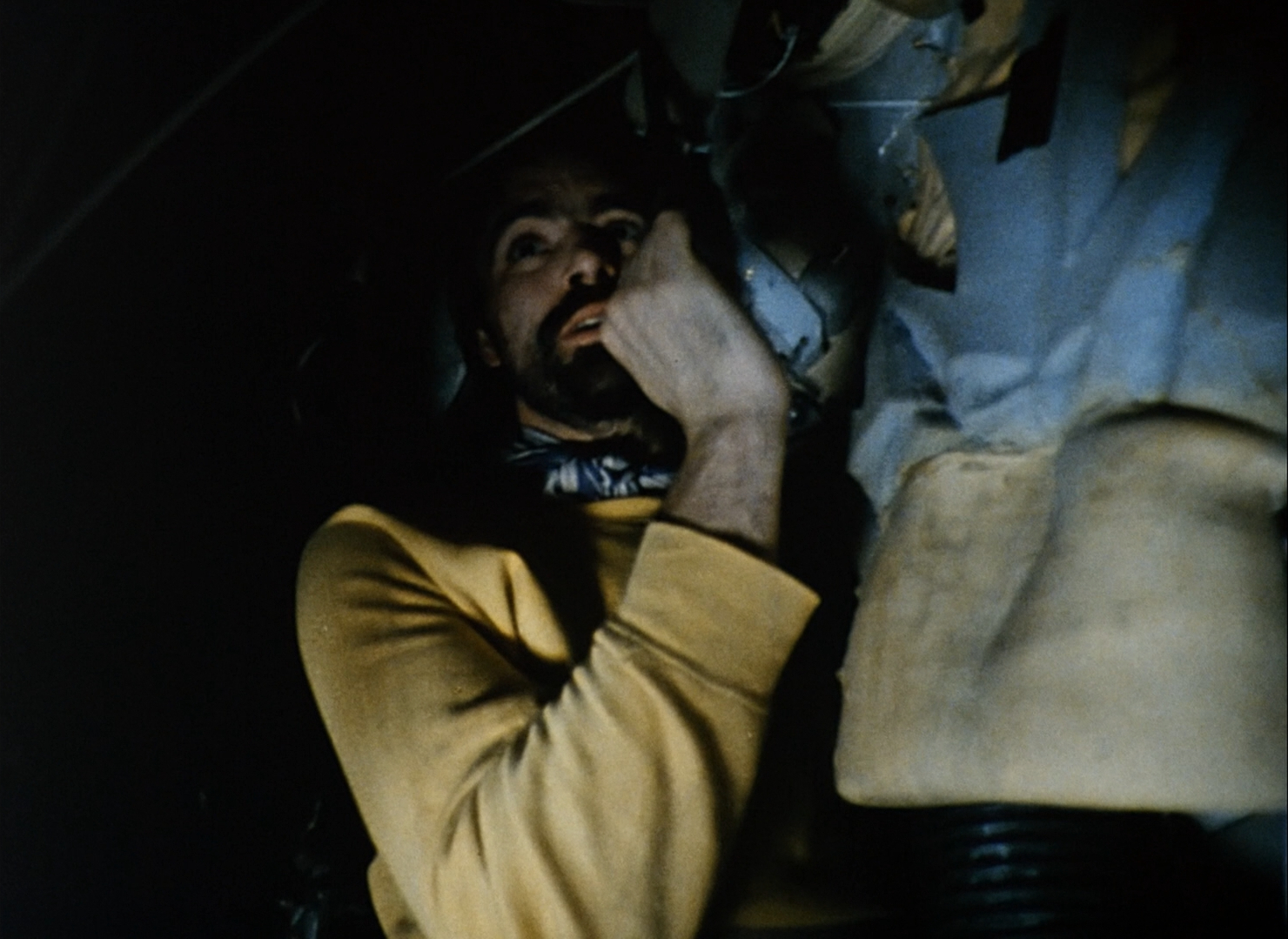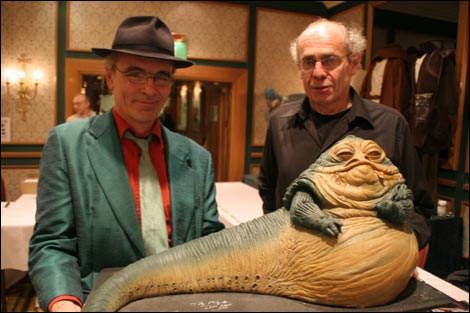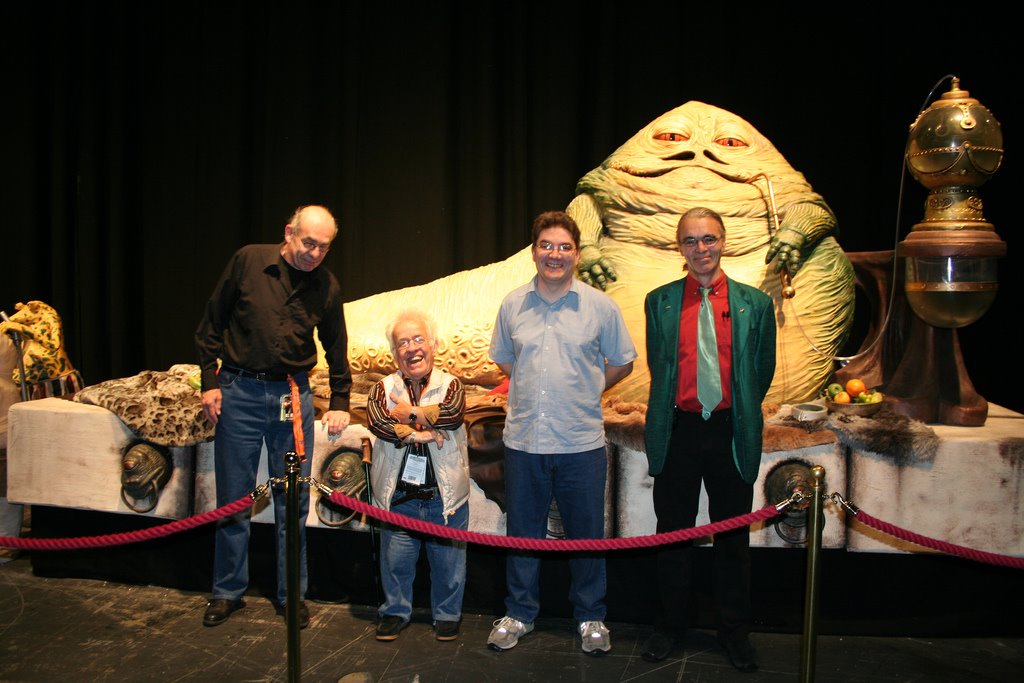The next year, Philpott was approached to serve as one of the puppeteers controlling Jabba Desilijic Tiure in Return of the Jedi. Philpott controlled the left arm, head, tongue, and body of the giant Hutt puppet. Philpott would lend his puppetry skills to other such movies as The Company of Wolves (1984), Labyrinth (1986), Little Shop of Horrors (1986) and Who Framed Roger Rabbit (1988) before leaving the film industry. He currently works as a library technician at the Cardiff Central Library in Cardiff, Wales. Reflecting upon his movie career, Philpott describes himself as a "street juggler that got lucky."
While working on The Dark Crystal at Jim Henson's Creature Shop, rumors began to circulate that alien characters for Return of the Jedi were being developed at that same studio, and several of the puppeteers began looking for ways to get a job on the film. David Barclay, who had been a puppet builder for The Dark Crystal, was chosen as one of the operators of the massive Jabba the Hutt puppet, and asked for Toby Philpott to be hired as his partner. Philpott, who was unaware of Barclay's politicking on his behalf, was surprised by the sudden job offer and eagerly accepted it.

Toby Philpott working inside the Jabba puppet on the set of Return of the Jedi.
Barclay was the chief Jabba puppeteer who planned all the movements and guided all the other performers; Philpott controlled Jabba's left arm, with which he controlled many of Jabba's more active motions, including eating Klatooine paddy frogs, smoking the Hookah pipe, and physically assaulting Bib Fortuna and C-3PO. Philpott also used his right hand to control Jabba's tongue and animate his head, and controlled the body by swiveling his seat with his legs braces. Cable controls allowed Philpott to swivel the head and snarl Jabba's Mouth.
The rest of the puppet team included Barclay on the right arm and mouth; Mike Edmonds on the tail; and John Coppinger, who controlled the eyes via remote control and gave the others feedback based on what he saw from the outside. Philpott would later describe sitting inside the Jabba puppet with Barclay as being "like a two-man submarine" because it was very hot, cramped, and uncomfortable. A monitor inside the puppet shows a general shot of Jabba that helped the puppeteers operate, although they could not tell where the frame of the shot was from the image; the team depended on feedback amongst themselves, and their training under Jim Henson gave them experience in coordinating to create a single creature.
Philpott and Barclay would go inside the puppet early in the day and remain there for almost the entire nine-and-one-half hours of filming each day, so much so that other cast and crew members did not know who they were during breaks. The two would only occasionally leave the suit to directly discuss Jabba-related business, but preferred to remain in character within the suit. Philpott and Barclay employed an approach by Jim Henson in which they took direction while in character; director Richard Marquand agreed to give Jabba direction as if the character was the actor, and they talked back to the director as if the puppet itself were a live performer.
It took about three weeks to film the Jabba's Palace scenes, and an additional week to film the Sail Barge scenes; Philpott and the puppeteers said they experienced few problems operating Jabba due to the effective design work of Phil Tippett, Stuart Freeborn, and John Coppinger. Philpott's previous experience with The Dark Crystal helped prepare Philpott for the role of Jabba, although as a result, he later said he wasn't as "overawed" by the experience as he might have been. Nevertheless, he described the experience as "great fun" and said he enjoyed being the center of attention among the many other puppets and live actors in Jabba's Palace.
During the scene when a captured Princess Leia Organa is presented to Jabba after freeing Han Solo from the carbonite, Marquand told Philpott to try to get Jabba to really lick the side of Carrie Fisher's face in order to create a genuine disgusted reaction. Philpott resisted at first since the tongue, which was covered in K-Y Jelly, was difficult to control, but Marquand eventually convinced him to do it. During the scene in which he made the attempt, Philpott accidentally stuck the tongue right into Fisher's ear, which caused a small commotion on the set, although Philpott was unaware of what he did from within the Jabba costume until he later took a break from filming.
The brief scene in which Jabba eats the frogs took several takes to get correctly since it was difficult for Philpott to reach Jabba's mouth with the left arm; the filmmakers originally tried to use an actual frog but it kept escaping and hopping around the set. The final scene Philpott filmed was the death of Jabba the Hutt; he and the other puppeteers "trashed around and went crazy" and Philpott said once Carrie Fisher realized she couldn't hurt the performers inside Jabba, "she really went for it." Philpott described actor Harrison Ford as "rueful, and funny as he appeared;" actress Carrie Fisher as mischievous on the set and petulant due to being stuck in a long contract; and actor Mark Hamill was "a bit insecure" and not nearly as boyish as he seemed on-screen. Like most bit players in the original Star Wars trilogy, Philpott was bought out of his contract in 1983, the year Return of the Jedi was released, and thus receives no future royalties for his participation in the film.

Toby Philpott and John Coppinger, Jabba the Hutt sculptor.
Philpott remains well known for his animatronics work, particularly on Return of the Jedi, and attends occasional science fiction conventions to meet fans and sign autographs, including Celebration Europe in 2007. Philpott said he had no idea how large the Star Wars fanbase was until he started using the Internet in 1999.

Jabba the Hutt sculptor John Coppinger with Jabba puppeteers Mike Edmonds, David Barclay and Toby Philpott at Celebration Europe.
Following the 1997 Star Wars Special Edition theatrical re-release of A New Hope, Philpott said he did not like the new animated Jabba the Hutt featured in a previously-cut scene and, although he was interested in the future possibilities brought about by computer-generated imagery, he lamented the increased use of computer animations rather than animatronics and real performers. Philpott did not dismiss CGI altogether, especially when it appears seamless and convincing as he believed it did in Steven Spielberg's 1993 film, Jurassic Park. However, he felt puppetry and animatronics often lent a more convincing look to the movies than the "slick hyper-reality" of some computer effects, and feels puppeteers have the unique ability to improvise and interact with the performers, unlike computer-generated images. Philpott would later admit, however, that the animated Jabbas that appeared in the 2004 DVD re-release of Return of the Jedi and the 1999 prequel The Phantom Menace were significant improvements over the special edition incarnation.
- Classic Creatures: Return of the Jedi
- Star Wars: The Skywalker Saga – The Official Collector's Edition
- "Inside Jabba the Hutt" — Star Wars Insider 209